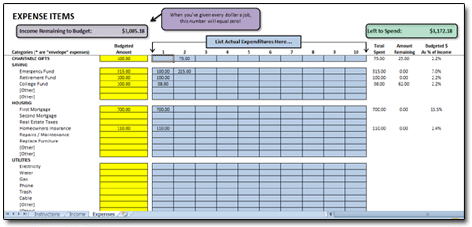Excel Monthly Cash-Flow Budget Spreadsheet
(based upon Dave Ramsey's "Cash-Flow Budget" Forms)
| Price: | Nil! Free! Gratis! |
| File Type: | Excel Spreadsheet (.xls & .xlsx) |
| Operating System: | Microsoft Windows |
| Software Req'd: | MS Excel 2003 or Later |
| File Size: | ~98kb (.ZIP) |
| Last Update: | October, 2018 |
| Current Version: | 1.5 |
| Macros: | No [What's this?] |
Fans of Dave Ramsey and readers of his ultra-popular Total Money Makeover will undoubtedly recognize the following spreadsheet setup:
After creating a whole host of budgeting spreadsheets — the Simple Budget, Box Budget, and my popular IYM Spending Plan among them — I decided it was time to give Dave Ramsey followers a chance to get in on the spreadsheet action.
Ramsey's 2003 edition of his Total Money Makeover Workbook contains paper forms for what he calls a "Monthly Cash-Flow Plan." I studied the forms, and adapted (I hope!) their financial goodness to this Cash-Flow Budget spreadsheet.
You can grab your free copy below:
Spreadsheet Requires Excel 2003 or Later
The Cash-Flow Budget isn't a stand-alone program. Instead, it's an Excel spreadsheet. This means that it requires that you have Microsoft Excel 2003 or later installed on your computer for it to operate.
(Unfortunately, no, Microsoft Works is not the same as Microsoft Excel, and will not run Excel spreadsheets.)
As far as operating-system requirements, it should work on Windows XP and all later versions of Windows.
Dave Ramsey & Budgeting
When a particular envelope was empty, they stopped buying that particular item because the money budgeted for the category was gone. So, if you wanted a shirt but the clothing envelope was empty, you didn't buy the shirt that month.
You might guess that financial guru Dave Ramsey, creator of the Baby Steps plan for financial security, is big on budgeting.
Actually, you'd be wrong, because in reality he's ABSOLUTELY INSISTENT on budgeting. He is, in fact, probably one of budgeting's largest proponents ANYWHERE on the planet. (The planet Saturn may have someone on it who's a bigger fan of budgeting, but I can't speak to that.)
To be more precise, Ramsey preaches the merits of two types of budgeting: "zero-based" budgeting, and the "envelopes" system of spending control. Done correctly, these two ideas really intertwine nicely.
Zero-Based Budgeting
In zero-based budgeting, every dollar of income gets a job. That is to say, at the start of each month, you'll sit down and estimate as best you can just how much income you'll receive during the upcoming month. Then, via the use of this spreadsheet (of course!), you will proceed to spend every dollar on paper before you spend it in real life. You'll budget every dollar of income toward savings or expenses. When every bit of expected income has been budgeted toward something, you'll have ZERO left over. That's zero-based budgeting in a nutshell.
Envelopes Budgeting
Some budgeting categories — like food, clothing, and "blow money" — are, due to their very nature, difficult to budget for ... and perhaps even harder to rein into an already-created budget. (Who here wouldn't go overboard on food spending if a freshly-made tiramisu came on sale?)
For Ramsey, that's where envelopes come in.
Once you decide that, say, $200 of this month's income will go toward groceries, then simply put that $200 cash into an envelope labeled GROCERIES. When it's time to go food shopping, you take the envelope (or better yet, just some money from it) along with you to the store. When the GROCERY envelope is empty, that's it. No more grocery spending UNLESS you take money from one of your other categories to make up the shortfall.
More Details Inside!
You'll find more specific instructions inside the spreadsheet; just check the INSTRUCTIONS worksheet for all the nitty-gritty, how-it-works stuff.
Don't be nervous, though. It's not complicated at all!
Questions? Comments? Contact Me!
Got a question or issue? Don't hesitate — drop me a line. I'll get back to you as soon as possible!



